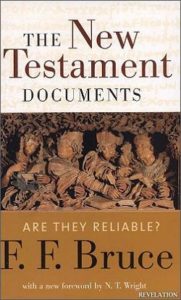Book Review: The New Testament Documents
 Author: F. F. Bruce
Author: F. F. Bruce
Publisher: Wm. B. Eerdmans Publishing Company & Intervarsity Press
Originally Published: 1943
ISBN: 978-0-8028-2219-2
Over the past 2,000 years, the Bible has withstood onslaught after onslaught of varying attacks. Men have tried to outlaw it and they have tried to destroy it, yet still it exists and is read. Over the past few centuries, a new attack has taken place – an attempt to discredit the Bible. After all, if it can be proven that the Bible is historically inaccurate, then can it really be the Word of God? In fact, how can we even know if the New Testament story is genuine? Could it be nothing more than a legend concocted centuries after the events supposedly took place? Can we even be confident that the Bible we read today is the same message as what was originally written? These are all important questions. Many have tried to argue that the Bible is inaccurate, that it has been changed throughout the ages, and that it gives us something far different than the real picture of the historical Jesus. So how do we answer these questions?
There are many resources available now that answer these questions, but a solid and easily understandable work is that of scholar F.F. Bruce titled, The New Testament Documents: Are They Reliable? This book was originally printed in 1943, so it is fairly old, but it still stands as a great resource for those wanting to understand more about the accuracy of the New Testament.
Bruce briefly discusses the importance of the topic in his first chapter, and then addresses two major issues in chapters two and three. Those issues are the dating of the New Testament writings and the canon of Scripture. Critics frequently claim that the books of the New Testament were written centuries after the events took place, and thus are at best unreliable, or at worst they are mere fabrications and legends. In a fairly short space, Bruce adequately lays out the evidence to show the New Testament was written much earlier than critics claim. Further, Bruce demonstrates how much better the manuscript evidence is for the Bible than any other work of ancient history. Just one example of many Bruce gives is that of Caesar’s Gallic War which was written between 58 and 50 B.C. We only have nine or ten truly usable manuscripts still in existence, and the earliest date those come from is the ninth century. That’s 900 years later! With the Bible, we have thousands of manuscripts, the earliest of which from about 130 AD. To question the accuracy or legitimacy of the Bible while accepting Caesar’s history is clearly hypocritical.
Bruce also addresses the issue of the canon – another very important subject. Especially in recent years, more people have bought into an idea that there are other gospels and works that could easily have become part of the New Testament, but they were rejected by the Catholic church or other men over time. Clearly, the implications for such a claim are huge. Bruce does a masterful job , however, of laying out the evidence that critics refuse to accept – evidence that shows we can be very confident in the books which comprise the New Testament in our Bibles today.
Chapter four is by far the largest section of the book, and in it Bruce discusses various issues pertaining to the Gospels. Some critics see nothing but contradictions in the Gospels. Other critics claim they were works of plagiarism because of their similarities. Bruce addresses nearly all of these concerns in a very scholarly way. This is probably the most technical chapter of the book, and some will not agree with Bruce’s comments about possible sources for the Gospels. Be that as it may, it is a very good chapter, and in my opinion, Bruce lays out one of the most straightforward explanations of “source theories” I’ve seen.
The remaining chapters of the book are all fairly short, but still very helpful. Especially helpfully is the chapter demonstrating Luke’s accuracy as a historian, and the final chapters that list various extra-biblical sources (both Jewish and Gentile) that corroborate the narrative of the New Testament. Bruce also has chapters dealing with the miracles of the Gospels, the importance of Paul’s writings, and various archaeological evidence.
Overall, I think The New Testament Documents is a great book and fantastic resource, especially given the alarming amount of people (religious and irreligious) that are making claims against the accuracy of the Bible today. At only 124 pages it is a fairly quick read, and even though it is written by a scholar about scholarly topics, it is written at a level that I think nearly everyone can understand and appreciate. I highly recommend this book for all students of the New Testament, especially those that want to be equipped to defend the reliability and accuracy of the Bible!
At the time of this writing, Nathan Battey has a few copies of this work available on the Christian Researcher site for $5.95.
This book is also available new on Amazon for $9.81
Book review by: Nate Bibens